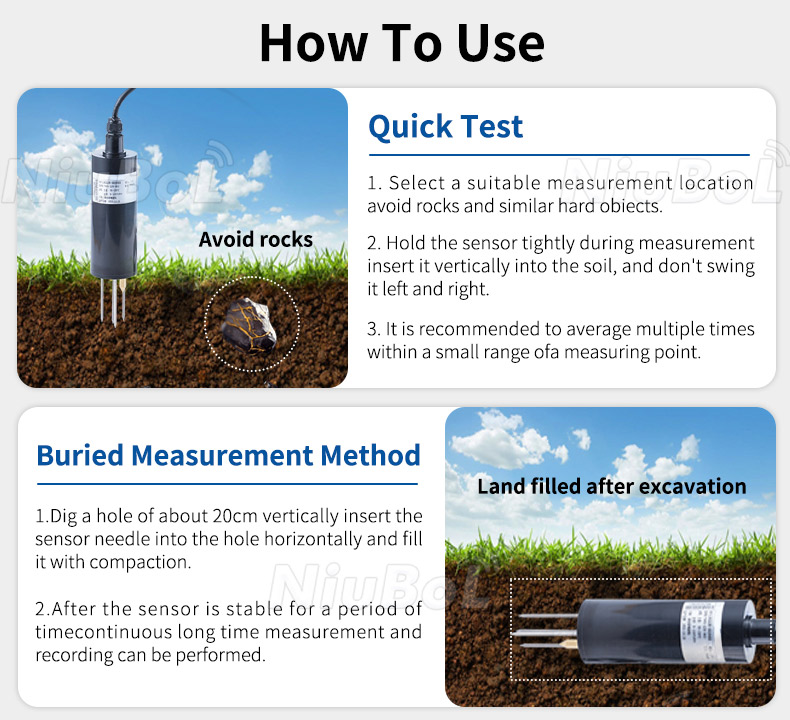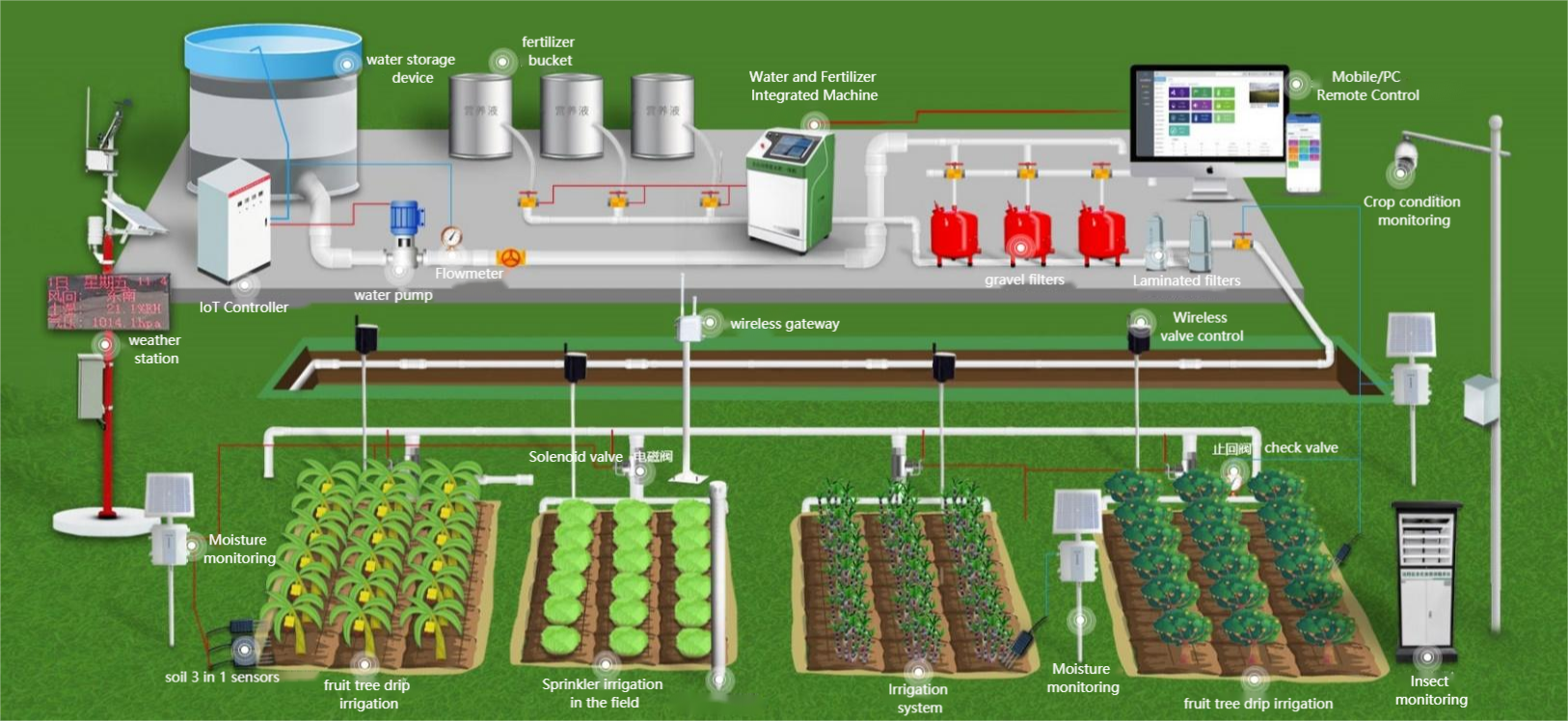

— Blogs —
—Products—
 Consumer hotline +8618073152920
Consumer hotline +8618073152920 WhatsApp:+8615367865107
Address:Room 102, District D, Houhu Industrial Park, Yuelu District, Changsha City, Hunan Province, China
Product knowledge
Time:2025-10-18 10:06:37 Popularity:720
Soil is a harsh battlefield.
Beneath the surface lies a dynamic environment filled with moisture, salts, microorganisms, and constant temperature fluctuations. For soil moisture sensors, these challenges determine not only measurement accuracy but also service life and total cost of ownership (TCO).
In agricultural irrigation, hydrological research, and environmental monitoring, project feasibility depends heavily on sensor reliability. Frequent replacement, recalibration, or signal drift can lead to inconsistent data and costly downtime.
At NiuBoL, we believe that a soil sensor should endure like the soil itself — resilient, precise, and ready for the long haul.

Sensor lifespan is closely tied to both measurement principle and material design. Below is a comparative overview of mainstream technologies.
Expected Lifespan: 1–3 years (shortest among all types)
Limitations:
Electrodes corrode easily under moisture and salts.
Gypsum or salt-based filler materials gradually dissolve, leading to drift and failure.
Sensitive to soil EC and temperature variations.
Best for: Temporary field experiments or low-cost monitoring projects.
Expected Lifespan: 3–7 years
Durability Factors:
Probe material and potting quality determine long-term stability.
Proper epoxy encapsulation and sealed PCB housings are critical to block moisture ingress.
Best for: Precision agriculture, smart irrigation, and greenhouse monitoring.
Expected Lifespan: 5–10+ years (industrial grade)
Durability Advantages:
Measures dielectric permittivity via electromagnetic wave travel time — immune to soil salinity drift.
Built with stainless steel rods and fully sealed electronics.
Excellent long-term repeatability, ideal for scientific and industrial applications.
Best for: Long-term climate observation, hydrology networks, and research-grade data collection.
High salinity or extreme pH accelerates electrochemical corrosion of metal electrodes. Stainless steel and coated probes show superior endurance in saline or alkaline soils.
Farm Machinery Impact: Tillage or plowing can damage exposed probes or cables.
Freeze–Thaw Stress: Water expansion during freezing causes soil pressure shifts, leading to structural fatigue.
Even a perfectly designed sensor can fail if water enters through the connector.
Choose sensors with IP68-grade waterproofing, and ensure cable glands remain tightly sealed and strain-relieved.
Microbial growth, root entanglement, and organic coatings may alter sensor dielectric response. Periodic inspection and gentle cleaning help maintain signal accuracy.
Prepare the installation hole carefully to avoid air gaps.
Insert the probe firmly in the correct orientation (horizontal or vertical).
Backfill with native soil and compact layer by layer for good contact.
Keep connectors above ground or housed in waterproof junction boxes.
Mark sensor locations with visible stakes.
Avoid tractor paths or tilling zones.
In regions with deep frost, consider seasonal removal or insulation before freezing periods.

Use stainless steel or anti-corrosive coated probes for saline or high-humidity environments.
For research stations, opt for TDR/FDR sensors with industrial encapsulation standards.
Inspect cables annually for rodent damage or wear.
Validate readings with gravimetric (oven-drying) samples or reference sensors.
Replace connectors or gaskets showing cracks or discoloration.
In a 5-year climate monitoring project, an international research institute deployed [NiuBoL] TDR soil moisture sensors across semi-arid grasslands in Africa.
The sensors faced scorching heat, seasonal flooding, and frequent sandstorms.
After a decade of operation, laboratory validation confirmed that the sensors maintained over 98% data consistency, proving the long-term reliability of TDR technology and [NiuBoL]’s industrial-grade sealing design.
“5 years of continuous, accurate data — that’s the kind of trust only durable engineering can deliver.”
— Dr. M. Kamba, Hydrology Research Lead, African Climate Network 
A1: Yes, but with caution. High salinity affects resistive and capacitive readings. We recommend TDR sensors or FDR sensors with EC compensation for saline soils.
A2: Install the new sensor beside the old one for at least one week of parallel logging. This allows comparison and offset calibration to ensure smooth time-series transition.
A3: Most modern sensors come factory-calibrated. For scientific-grade precision, perform site-specific calibration using gravimetric methods to fine-tune for soil texture differences.
A4: With 7–10 years of service life and minimal maintenance, industrial-grade TDR/FDR sensors typically deliver full ROI within 2–3 growing seasons, especially when integrated with automated irrigation systems.
At NiuBoL, we design sensors that don’t just measure — they endure.
From high-grade stainless steel probes to aerospace-grade sealing materials, every component of our TDR/FDR soil moisture sensors is engineered for decade-long performance in the toughest soil environments.
When you choose NiuBoL, you’re not just buying a sensor —you’re investing in data continuity, field reliability, and long-term profitability. NiuBoL Soil Moisture Sensors — Durability that keeps your data alive.
1.NBL-S-THR Soil Temperature Moisture Sensor datasheet
NBL-S-THR-Soil-temperature-and-moisture-sensors-Instruction-Manual-V4.0.pdf
2. NBL-S-TMC Soil Temperature Moisture EC Sensor datasheet
NBL-S-TMC-Soil-temperature-and-moisture-conductivity-sensor.pdf
3. NBL-S-TM Soil Temperature Moisture Sensor datasheet
NBL-S-TM-Soil-temperature-and-moisture-sensor-Instruction-Manual-4.0.pdf
4. NBL-S-TMCS Soil Temperature, Moisture, Conductivity and Salinity Integrated Sensor
NBL-S-TMCS-Soil-Temperature-Humidity-Conductivity-and-Salinity-Sensor.pdf
Related recommendations
Sensors & Weather Stations Catalog
Agriculture Sensors and Weather Stations Catalog-NiuBoL.pdf
Weather Stations Catalog-NiuBoL.pdf
Related products
 Combined air temperature and relative humidity sensor
Combined air temperature and relative humidity sensor Soil Moisture Temperature sensor for irrigation
Soil Moisture Temperature sensor for irrigation Soil pH sensor RS485 soil Testing instrument soil ph meter for agriculture
Soil pH sensor RS485 soil Testing instrument soil ph meter for agriculture Wind Speed sensor Output Modbus/RS485/Analog/0-5V/4-20mA
Wind Speed sensor Output Modbus/RS485/Analog/0-5V/4-20mA Tipping bucket rain gauge for weather monitoring auto rainfall sensor RS485/Outdoor/stainless steel
Tipping bucket rain gauge for weather monitoring auto rainfall sensor RS485/Outdoor/stainless steel Pyranometer Solar Radiation Sensor 4-20mA/RS485
Pyranometer Solar Radiation Sensor 4-20mA/RS485
Screenshot, WhatsApp to identify the QR code
WhatsApp number:+8615367865107
(Click on WhatsApp to copy and add friends)
